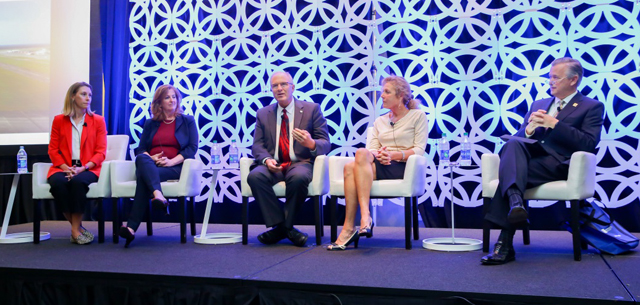Commercial Space – The Next Frontier for Airports
![]() Print this Article | Send to Colleague
Print this Article | Send to Colleague

In 1909, 109 years ago, the first commercial airport opened in Maryland. Today, there are 5,116 public airports and 14,485 private airports. Now, think of that in a commercial space context with “now” being the beginning of what may be exponential growth in that arena. “We are exactly in the same position with commercial space,” said Steve Grossman, CEO, Jacksonville Aviation Authority, “specifically horizontal launch,” at least at Jacksonville’s Cecil Spaceport, the site of the first (and only) horizontal launch spaceport license. Not only that, but the spaceport is already complete and “sometime in 2019, we expect the first commercial launch” via Generation Orbit, which has a contract with the U.S. Air Force.
There are 11 licensed launch and reentry sites in the U.S., with the most recent, Colorado, being licensed a couple of months ago, said Dorothy “Di” Reimold, Acting Deputy Associate Administrator for Commercial Space for the U.S. Federal Aviation Administration’s Office for Commercial Space Transportation (FAA AST). On FAA’s side, it is a testing ground too. While Aviation is regulated under FAA’s Title 49 United States Code, Commercial Space Transportation is under Title 51. “We have three active Aviation Rulemaking Committees (ARCs) related to commercial space transportation,” said Reimold. Plus, they are trying to come into a mode of operation that “is more akin to how the FAA manages aviation.” A program was launched called the Space Data Integrator “to more fully automate the space data directly so it can be calculated much more quickly,” she explained.
Sharon Pinkerton, Senior Vice President, Legislation and Regulatory Policy, Airlines for America, shared a different perspective: the challenges that space flight creates for airline flights. For example, “whole swaths of airspace have to be shut down” when a space flight is planned, which will have an impact on commercial aviation flow. And, “operational and safety impacts need to be addressed,” she emphasized.
Safety is of primary importance for all involved in commercial space, but especially so for SpaceX, a private entity that has 15 launches already under its belt for 2018. Caryn Schenewerk, Senior Counsel and Senior Director, Space Flight Policy, SpaceX, said, “Soon we’ll be carrying astronauts to the space station.” Their vehicles include: Dragon, Falcon 9, Falcon Heavy and BFR (Big Falcon Rocket). “We signed a customer to fly around the moon on BFR,” said Schenewerk, mentioning that SpaceX is the first private entity to launch, dock and bring a rocket back. “We can reuse our boosters up to 10 times without major work.”
For everyone involved, the challenge is going to be in the unknown. There is no route to follow, so trailblazing is the only way to go. “This is all very new for everyone,” said Grossman. “We are really looking forward to the future of all of this.”
